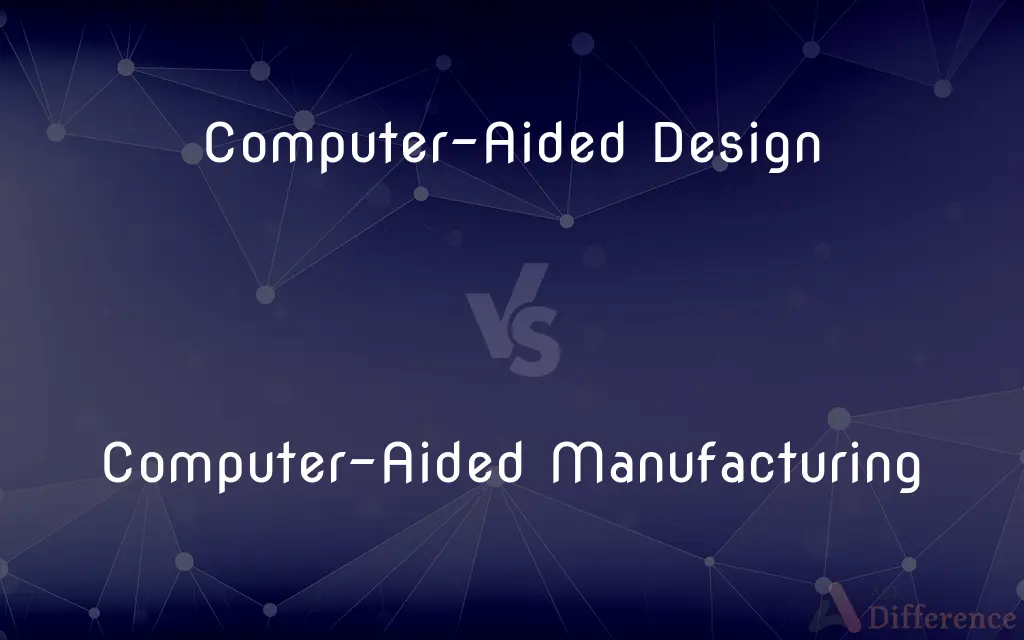Computer-Aided Design vs. Computer-Aided Manufacturing — What's the Difference?
By Tayyaba Rehman & Urooj Arif — Published on February 8, 2024
CAD involves using computer software for the creation, modification, and analysis of designs. CAM uses computer software to control machine tools and related machinery in the manufacturing process.

Difference Between Computer-Aided Design and Computer-Aided Manufacturing
Table of Contents
ADVERTISEMENT
Key Differences
Computer-Aided Design (CAD) is a process that leverages computer systems to facilitate the creation, modification, and optimization of a design. It provides a digital platform for draftsmen and designers to create detailed engineering layouts, drawings, and models. Conversely, Computer-Aided Manufacturing (CAM) involves the use of computer systems to plan, manage, and control the operations of manufacturing plants and machinery. CAM systems interpret CAD data and automate the manufacturing process.
CAD is primarily used in the initial stages of a product's lifecycle, focusing on the conceptualization and design of products. It allows designers to visualize and test their designs in a virtual environment. On the other hand, CAM is used in the later stages, where the focus shifts to the production aspect. CAM systems use the designs created in CAD software to control and guide the machinery used in manufacturing.
In CAD, the emphasis is on creating accurate and detailed 3D models or 2D drawings of physical components. This process involves various tools and features like geometric modeling, computer graphics, and drafting. CAM, however, centers around converting these CAD models into machine-readable instructions. It involves tasks like tool path generation, simulation of machining processes, and quality control.
The functionality of CAD software is diverse, ranging from architectural design and engineering to product design and animation. It offers a flexible environment for innovation and creativity. CAM software, however, is more operationally focused, dealing with methodologies like numerical control (NC) programming, robotics, and computer-aided quality (CAQ).
In summary, while CAD is about designing and planning a product digitally, CAM is about the actual creation of that product through automated machinery. CAD is a tool for creativity and innovation in design, whereas CAM is a tool for efficiency and precision in manufacturing.
ADVERTISEMENT
Comparison Chart
Primary Focus
Design and Modeling
Manufacturing Process
Stage in Production
Initial Stages (Design)
Later Stages (Production)
Main Function
Creating Digital Models
Controlling Manufacturing Machines
User Base
Designers, Architects
Manufacturing Engineers
Output
Digital Designs, Drawings
Physical Products, Components
Compare with Definitions
Computer-Aided Design
CAD involves leveraging digital tools to simulate and analyze the functionality of a design.
The team used CAD to simulate airflow around the new drone design.
Computer-Aided Manufacturing
CAM refers to the use of computer systems to manage, control, and automate manufacturing processes.
CAM technologies enabled the rapid production of high-precision aerospace components.
Computer-Aided Design
CAD is a technology concerned with using computer systems to create, edit, and analyze digital models and drawings.
Engineers employed CAD to test different aerodynamic shapes for the new car model.
Computer-Aided Manufacturing
CAM is the application of computer technology to automate manufacturing processes and improve efficiency.
CAM systems streamlined the production line, reducing manual labor and error.
Computer-Aided Design
CAD refers to designing and drafting with the help of a computer.
The jewelry designer crafted intricate patterns using CAD.
Computer-Aided Manufacturing
CAM is the use of computer software to control machine tools and related equipment in a manufacturing process.
The factory implemented CAM to automate the assembly line, improving efficiency.
Computer-Aided Design
CAD is the process of using computer software for the meticulous planning and designing of products, buildings, or machinery.
CAD software made it possible to design complex circuit boards with precision.
Computer-Aided Manufacturing
CAM involves applying computers and software to optimize and control manufacturing operations.
CAM was crucial in programming the robotic arms for precise welding in car manufacturing.
Computer-Aided Design
CAD is the use of computer systems to assist in the creation, modification, and optimization of a design.
The architect used CAD to visualize the new building's design before construction began.
Computer-Aided Manufacturing
CAM is a system that uses computer-aided designs to guide and control production machinery.
Using CAM, the company was able to produce complex parts for machinery more quickly.
Common Curiosities
Can CAD and CAM work together?
Yes, CAD designs are often used as inputs for CAM systems to facilitate automated manufacturing.
What industries use CAD?
Industries like architecture, engineering, automotive, and product design commonly use CAD.
Can CAM operate without CAD?
While possible, CAM is most efficient when used with CAD designs.
How does CAM impact manufacturing?
CAM increases efficiency, precision, and consistency in manufacturing processes.
What industries benefit from CAM?
CAM is extensively used in industries like aerospace, automotive, electronics, and manufacturing.
Does CAM reduce manufacturing time?
Yes, CAM can significantly reduce manufacturing time and costs.
Are there different types of CAD software?
Yes, there are various CAD software types, each specialized for different design needs.
How does CAD benefit designers?
CAD allows for precise and flexible design, providing a platform for innovation and detailed visualization.
What is CAD?
CAD is a process of using computers to aid in the design, modification, and analysis of a model or drawing.
Is CAD only for 3D modeling?
No, CAD can be used for both 3D modeling and 2D drafting.
What is CAM?
CAM uses computer software to control and automate the machinery and processes in manufacturing.
What skills are required for CAD?
Skills in design, geometry, and computer software are essential for CAD.
What skills are necessary for CAM?
Knowledge in manufacturing processes, computer programming, and engineering principles is vital for CAM.
Is CAD software easy to learn?
Learning CAD can vary in difficulty depending on the software and user's background.
Can CAM ensure product quality?
Yes, CAM can improve product quality by ensuring consistent and precise manufacturing.
Share Your Discovery

Previous Comparison
Novak Djokovic vs. Rafael Nadal
Next Comparison
Intel i3 vs. Intel i5Author Spotlight
Written by
Tayyaba RehmanTayyaba Rehman is a distinguished writer, currently serving as a primary contributor to askdifference.com. As a researcher in semantics and etymology, Tayyaba's passion for the complexity of languages and their distinctions has found a perfect home on the platform. Tayyaba delves into the intricacies of language, distinguishing between commonly confused words and phrases, thereby providing clarity for readers worldwide.
Co-written by
Urooj ArifUrooj is a skilled content writer at Ask Difference, known for her exceptional ability to simplify complex topics into engaging and informative content. With a passion for research and a flair for clear, concise writing, she consistently delivers articles that resonate with our diverse audience.
















































